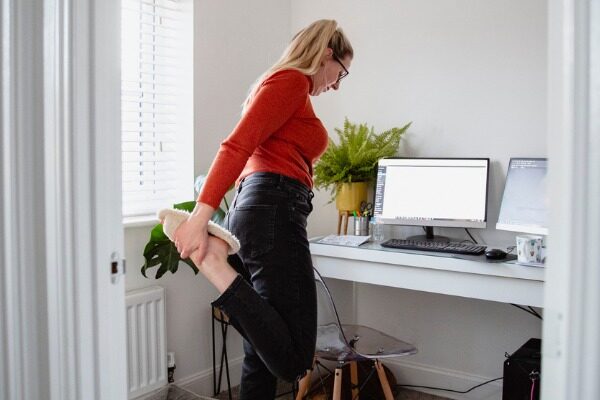None of us know how long we will be working from home for. David Andry, a physiotherapist, explains how we can prevent injuries and the ways to treat them.
I recently posted a short thread on Twitter about injury prevention and ergonomics. I’m a physiotherapist with over fourteen years of experience working in occupational health, and I’m also a certified ergonomic assessment specialist. I’ve done hundreds of onsite ergonomic evaluations and seen thousands of people with repetitive stress injuries. As more of us work at home, it’s important to prevent injuries and know how to cure them when they start.
So, if you work at a computer, a drawing table, on a tablet or any other repetitive-type workstation as part of your job, this article is for you. Even if you have never had discomfort, pain, numbness, weakness or any other symptoms, these tips can help you diminish stress on your body and help you to stay healthy longer.

1. Take regular microbreaks
As you stay in one position for a long time, especially a sitting position, your heart rate decreases and your circulation worsens. It is like your hands are running a marathon while trying to hold their breath.
I recommend that people without an injury stand and stretch every thirty minutes. It doesn’t have to be a long break but it needs to be frequent. I advise my patients to be proactive and not reactive. If you wait for symptoms to prompt you to get up and stretch it is already too late: tissue has been irritated and the inflammation process starts.
If you already have an injury, the breaks may be more regular. Again, take the break before the symptoms start – I’ve had patients take breaks every five minutes. Seems ridiculous, but the other option is to rest completely (gasp!) and let your body heal. Most freelancers and self-employed people cannot do this. An added benefit is that when you stand and stretch, your brain gets more blood flow as well. Microbreaks have been shown to improve focus and attention, so by stopping work you may be more efficient and actually get more work done.

2. Stretch how your body tells you
Great, so you’ve decided to take my advice and take a little break every thirty minutes. Now, what do you do during that break? Surprisingly, for a physical therapist, I am not picky with what stretches you do. Something that feels good is recommended – your body usually knows what it wants you to do.
Think about the position you have been in and do the opposite. Do you sit bent forward at the waist? Bend back. Head still looking straight ahead? Tilt your head to each side. Open and close your hands, stretch your wrist both ways, roll your shoulders back, squeeze your shoulder blades together, do a couple of squats, lift your heels up and stand on your toes.

3. Think about ergonomics
Ergonomics is all about minimizing stress on the body and adjusting the workstation to the worker. We want the body to be fairly neutral and reduce reaching.
That means your keyboard and mouse should be at elbow height when your arms hang at your side. It should almost feel like you are typing in your lap. Keep everything close. The top of the monitor should be at eye level so you just look forward or slightly down. The back of your chair should fit into the curve of your lower back like a puzzle piece, thighs supported but no pressure on the back of your knees, feet flat on the floor or on a footrest in front of you.
If you are an illustrator or artist, a slant table can be very helpful. If you hold brushes, pens, or pencils, making them thicker can be less irritating to your thumbs, hands, and forearms. I will have my patients wrap tape around their pens, usually using Coban or Kinesiotape. They are both squishy, adjustable, and removable. Coban usually only sticks to itself, so don’t worry about making your brushes sticky. Find a comfortable thickness and try to keep a relaxed grip. As we try to work faster, we usually grip harder, type harder, hit those mouse keys like we are mad at them. Keep it light!
4. Recover properly
So, you read this article too late and you already have an injury. Or you just want to do whatever you can to not have an injury. Meet your new best friend, the ice pack. Yes, ice. “But David, heat feels so good!” I hear you say. Well, not everything that feels good is good for us. Of course, this is my opinion and if you speak to other health care professionals you may hear different opinions. But in my experience, people that ice consistently recover better.
Look at a professional pitcher after a game. Huge pack of ice on his shoulder and elbow after. Why? So he can recover and do it again. That is what you are doing as well. Working all day at a repetitive task, recovering, and doing it again the next day. Apply ice for fifteen to twenty minutes right after work and before bed, until the area is numb.

5. Finally, prevention
If you want to keep these nasty injuries away, strengthen your body, especially your shoulder blade areas and rotator cuffs. Go for walks, get outside, and enjoy nature. Vary your tasks: if you have different types of work, switch between them instead of finishing all of one thing then going to another. If you develop pain that will not go away or numbness that wakes you up at night, see a healthcare professional.
Stay healthy and keep creating!






